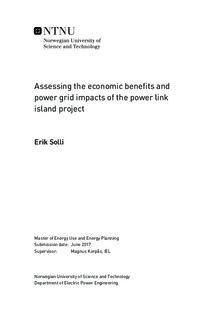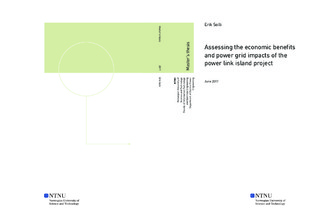| dc.description.abstract | Increasing penetration of renewable energy production bring new and tougher challenges for power systems and transmission system operators. This master s thesis includes three different case studies of a futuristic offshore power grid project including an artificial island in the North Sea named the power link island project. The idea behind the project is to use this island for transnational power exchange as well as a power distribution hub for offshore wind power. The purpose of this thesis is to assess the economic benefits of this type of grid expansion, as well as its impact on the power grid in its entirety.
The transmission expansion model PowerGIM is used for optimizing grid investments and it includes six countries, all bordering the North Sea. These countries are Great Britain, Belgium, the Netherlands, Germany, Denmark and Norway. The first case study includes three different degrees of offshore power grid development. In the second case study, three predetermined percentages of the onshore renewable energy production are moved from onshore to offshore nodes in the power system. In the last case study, the placement of additional offshore wind power prediction was researched. The data sets used in the investment model are based on futuristic visions for the European power system collected from the TYNDP 2016 published by ENTSO-E. All case studies include two sets of simulations, one for the least optimistic vision, and one for the most optimistic vision. The thesis assess the economic benefits of the power link island project, as well as the impacts the project has on the power system, investigating central attributes like project costs, transmission line expansions, transmission investments in areas, power exchange through the island as well as area prices.
It was an economic advantage to invest in the power link island for all simulated scenarios which allowed the power link island to be built, independent of futuristic vision. When examining different degree of power grid development in case 1, the project was even more profitable for simulations with futuristic scenarios having higher penetration of renewable energy production. The movement of predetermined percentages of renewable energy production from onshore to offshore nodes had a positive effect on the total costs of the project up to a certain extent. Combining the most promising results from the simulations done in the first two case studies gave a reduction of 12.56% and 15.85% in total costs for vision 1 and vision 4 respectively. This included a fully developed power grid with 25% of the renewable generation moved to offshore nodes.
Installing new offshore wind capacity in association with the power link island gave a reduction in total costs, compared to distributing the same capacity between offshore nodes of each area. An uneven distribution of transmission investment costs, different impacts on area prices in countries and the amount of capacity upgrades needed demands a strong cooperation between all participant countries regarding maritime spatial planning and development of incentive schemes. | |

